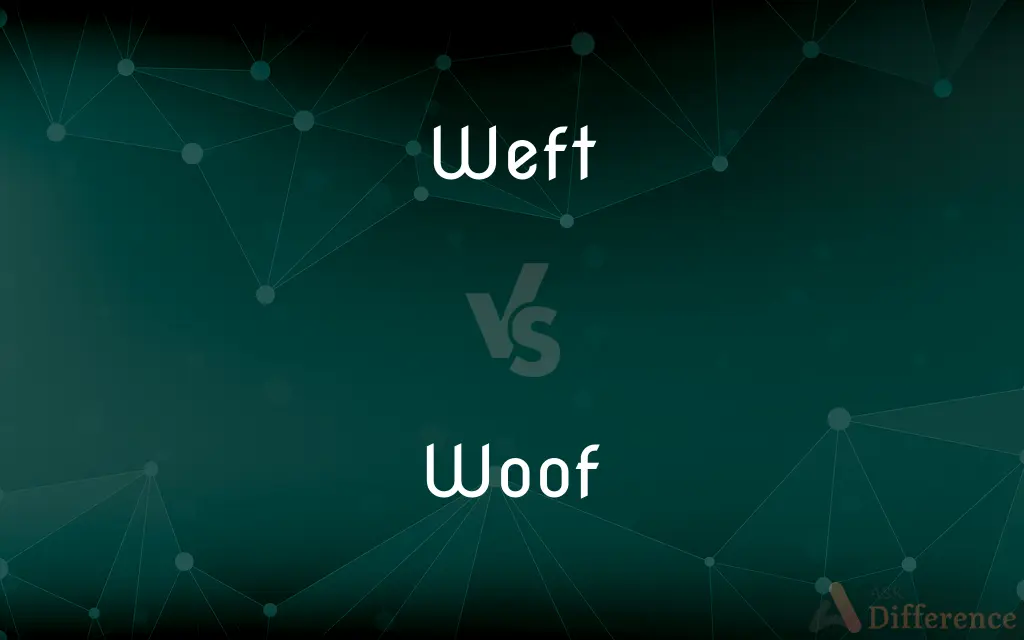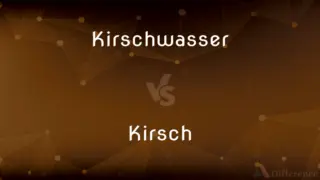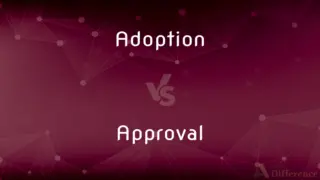Weft vs. Woof — What's the Difference?
By Fiza Rafique & Maham Liaqat — Updated on April 26, 2024
Weft and woof refer to the threads in woven fabric, with weft being the horizontal threads interlaced through the warp (vertical threads), and woof is an older term for the same weft threads.

Difference Between Weft and Woof
Table of Contents
ADVERTISEMENT
Key Differences
Weft, also known as the fill, consists of the horizontal threads that are woven through the vertical warp threads in fabric making. On the other hand, "woof" is an archaic term that was traditionally used interchangeably with weft to describe these horizontal threads. In modern textile terminology, "weft" is the preferred term.
In the weaving process, the weft threads are typically inserted using a shuttle or other tool that carries the thread through the warp. Whereas woof, being the same component under a different name, follows the identical process but is less commonly referred to in contemporary discussions on textiles.
The choice of weft (or woof) threads can significantly influence the texture, strength, and elasticity of the finished fabric. While both terms refer to the same set of threads, the terminology used can reflect the historical context or the traditional practices of weaving within different cultures.
Weft threads are crucial for the structural integrity of the fabric, as they interact with the warp to create various weaving patterns. Similarly, what was once called the woof plays the same role, and its impact on the design and function of textiles is identical, showcasing that the distinction lies only in terminology.
Textile professionals primarily use the term weft today to avoid confusion and standardize the language within the industry. In contrast, woof, though still understood, is mostly encountered in historical texts or in the context of explaining traditional weaving techniques.
ADVERTISEMENT
Comparison Chart
Definition
Horizontal threads in woven fabric
Older term for the same horizontal threads
Usage in Weaving
Interlaced through the warp
Interlaced through the warp
Impact on Fabric
Determines texture, strength, elasticity
Identical to weft
Modern Usage
Commonly used in textile industry
Less commonly used, considered archaic
Relevance
Essential for fabric structure
Historically important, same relevance as weft
Compare with Definitions
Weft
Commonly discussed in textile manufacturing.
Weft insertion is a critical step in the weaving process.
Woof
Involved in the same weaving patterns as weft.
Traditional designs relied heavily on the woof for artistic expression.
Weft
Horizontal threads woven through the warp.
The colorful weft threads create a vibrant pattern on the fabric.
Woof
Less common in modern textile discussions.
The term woof is rarely used today, except in historical contexts.
Weft
Plays a key role in fabric's structure.
The choice of weft material affects the cloth’s overall durability.
Woof
Archaic term for weft, used interchangeably.
The woof threads were historically made from natural fibers.
Weft
Essential in various weaving patterns.
Each weft pass adds to the complexity of the design.
Woof
Same role as weft in influencing fabric properties.
Woof threads in the old looms were crucial for fabric quality.
Weft
Can vary in material for different textures.
Silk weft gives the fabric a smooth, glossy finish.
Woof
Importance in textile history.
Understanding the role of woof helps in studying ancient weaving techniques.
Weft
The horizontal threads interlaced through the warp in a woven fabric; woof.
Woof
The threads that run crosswise in a woven fabric, at right angles to the warp threads; weft.
Weft
Yarn used for the weft.
Woof
The texture of a fabric.
Weft
Woven fabric.
Woof
The characteristically deep, gruff bark of a dog.
Weft
(weaving) The horizontal threads that are interlaced through the warp in a woven fabric.
Woof
A sound similar to a woof.
Weft
(weaving) The yarn used for the weft; the fill.
Woof
To make this sound.
Weft
(hairdressing) A hair extension that is glued directly to a person′s natural hair.
Woof
The set of yarns placed crosswise in a loom, interlaced with the warp, carried by the shuttle; weft.
Weft
(obsolete) Something cast away; a waif.
Woof
A fabric; the texture of a fabric.
Weft
A thing waved, waived, or cast away; a waif.
Woof
The sound a dog makes when barking.
Weft
The woof of cloth; the threads that cross the warp from selvage to selvage; the thread carried by the shuttle in weaving.
Woof
The sound of a dog barking.
Weft
A web; a thing woven.
Woof
(humorous) Expression of strong physical attraction for someone.
Weft
The yarn woven across the warp yarn in weaving
Woof
To make a woof sound.
Woof
(transitive) To devour; to gobble; to eat (something) voraciously.
Woof
The threads that cross the warp in a woven fabric; the weft; the filling; the thread usually carried by the shuttle in weaving.
Woof
Texture; cloth; as, a pall of softest woof.
Woof
The yarn woven across the warp yarn in weaving
Common Curiosities
What is the main function of the weft in weaving?
The weft provides the crosswise structure and contributes to the fabric’s design and mechanical properties.
Is there any difference in how weft and woof are used in weaving?
No, they are used identically in the weaving process; the difference lies only in terminology.
Why is the term "woof" less used today?
"Woof" is considered archaic and has largely been replaced by "weft" in modern textile terminology for clarity and standardization.
Can weft and woof be made from different materials?
Yes, both refer to the same threads which can be made from various materials like cotton, wool, silk, or synthetic fibers.
How does the choice of weft affect fabric durability?
The strength and elasticity of weft threads play crucial roles in the fabric’s durability and suitability for different uses.
Why is it important to know the distinction between weft and woof?
Understanding the terms helps in appreciating textile history and the evolution of weaving terminology.
Can the terminology affect how textiles are studied or collected?
Yes, understanding the correct terminology is crucial for proper documentation, study, and preservation of textile artifacts.
How do weft and woof affect the appearance of fabric?
They determine the texture, color pattern, and overall aesthetic of the fabric depending on the material and weaving technique used.
Are there any modern contexts where "woof" is still used?
It is occasionally used in discussions of historical textiles or in educational contexts to explain traditional weaving practices.
What impact does weft have on fabric elasticity?
Depending on the material, the weft can significantly impact the fabric’s stretchiness and how it drapes.
What historical significance does the term "woof" hold?
It reflects older linguistic and cultural approaches to textile manufacturing and is valuable in historical textile studies.
What are the typical materials used for weft threads?
Common materials include cotton, wool, silk, and various synthetic fibers, each offering different qualities to the fabric.
How do modern weavers view the term "woof"?
Modern weavers typically prefer "weft" for consistency but may reference "woof" when discussing traditional or historical weaving.
What weaving techniques specifically highlight the importance of weft?
Techniques like tapestry and denim production where the weft plays a dominant aesthetic and structural role.
How has the use of weft evolved in the textile industry?
Advances in materials and weaving technology have expanded the possibilities for weft in creating diverse and complex fabric structures.
Share Your Discovery

Previous Comparison
Kirschwasser vs. Kirsch
Next Comparison
Adoption vs. ApprovalAuthor Spotlight
Written by
Fiza RafiqueFiza Rafique is a skilled content writer at AskDifference.com, where she meticulously refines and enhances written pieces. Drawing from her vast editorial expertise, Fiza ensures clarity, accuracy, and precision in every article. Passionate about language, she continually seeks to elevate the quality of content for readers worldwide.
Co-written by
Maham Liaqat













































